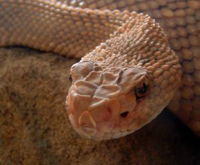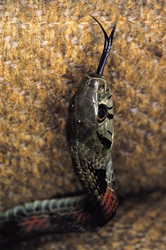Special Sense Organs
Reptiles, like some of the other groups of animals we have studied, have a nervous system. A nervous system is composed of nerves, a brain (in most cases), and sense organs, like eyes and touch receptors that send messages about the environment to the animal so it can respond accordingly. In reptiles we find a pretty complex nervous system that isn't too unlike that of a human.
 Pit vipers (a group of snakes that includes rattlesnakes and copperheads) have two heat-sensitive organs on their head that enable them to detect the smallest changes in temperature, like an internal alarm system. Even the approach of a warm-blooded creature, like you or me, is enough to set off the snake's alarm—or its dinner bell as the case may be.
Pit vipers (a group of snakes that includes rattlesnakes and copperheads) have two heat-sensitive organs on their head that enable them to detect the smallest changes in temperature, like an internal alarm system. Even the approach of a warm-blooded creature, like you or me, is enough to set off the snake's alarm—or its dinner bell as the case may be.
 Both snakes and lizards have a good sense of smell. Chemicals are very involved in the sense of smell. Chemicals in the air enter the nostrils and stimulate the olfactory (smell) receptors. These send signals to the brain and the brain registers the smell.
Both snakes and lizards have a good sense of smell. Chemicals are very involved in the sense of smell. Chemicals in the air enter the nostrils and stimulate the olfactory (smell) receptors. These send signals to the brain and the brain registers the smell.
 When snakes flick their tongue they are picking up different chemicals in the air; in a sense, they are tasting things nearby that have emitted an odor. This is remote sensing at its finest!
When snakes flick their tongue they are picking up different chemicals in the air; in a sense, they are tasting things nearby that have emitted an odor. This is remote sensing at its finest!
They do this with a special sensory receptor, called a Jacobson's organ, inside their head. It's a pit-like sense organ. When the snake draws its tongue inside its mouth, it inserts the tip into these pits and transfers any chemical molecules. The Jacobson's organ can analyze the chemicals—it's like a little chemistry lab that allows the snake to taste the air.
Close This Window
Images © clipart.com 2006 with the exception of the rattlesnake © Natasha Vincent 2006.
 Pit vipers (a group of snakes that includes rattlesnakes and copperheads) have two heat-sensitive organs on their head that enable them to detect the smallest changes in temperature, like an internal alarm system. Even the approach of a warm-blooded creature, like you or me, is enough to set off the snake's alarm—or its dinner bell as the case may be.
Pit vipers (a group of snakes that includes rattlesnakes and copperheads) have two heat-sensitive organs on their head that enable them to detect the smallest changes in temperature, like an internal alarm system. Even the approach of a warm-blooded creature, like you or me, is enough to set off the snake's alarm—or its dinner bell as the case may be.
 Both snakes and lizards have a good sense of smell. Chemicals are very involved in the sense of smell. Chemicals in the air enter the nostrils and stimulate the olfactory (smell) receptors. These send signals to the brain and the brain registers the smell.
Both snakes and lizards have a good sense of smell. Chemicals are very involved in the sense of smell. Chemicals in the air enter the nostrils and stimulate the olfactory (smell) receptors. These send signals to the brain and the brain registers the smell.
 When snakes flick their tongue they are picking up different chemicals in the air; in a sense, they are tasting things nearby that have emitted an odor. This is remote sensing at its finest!
When snakes flick their tongue they are picking up different chemicals in the air; in a sense, they are tasting things nearby that have emitted an odor. This is remote sensing at its finest!